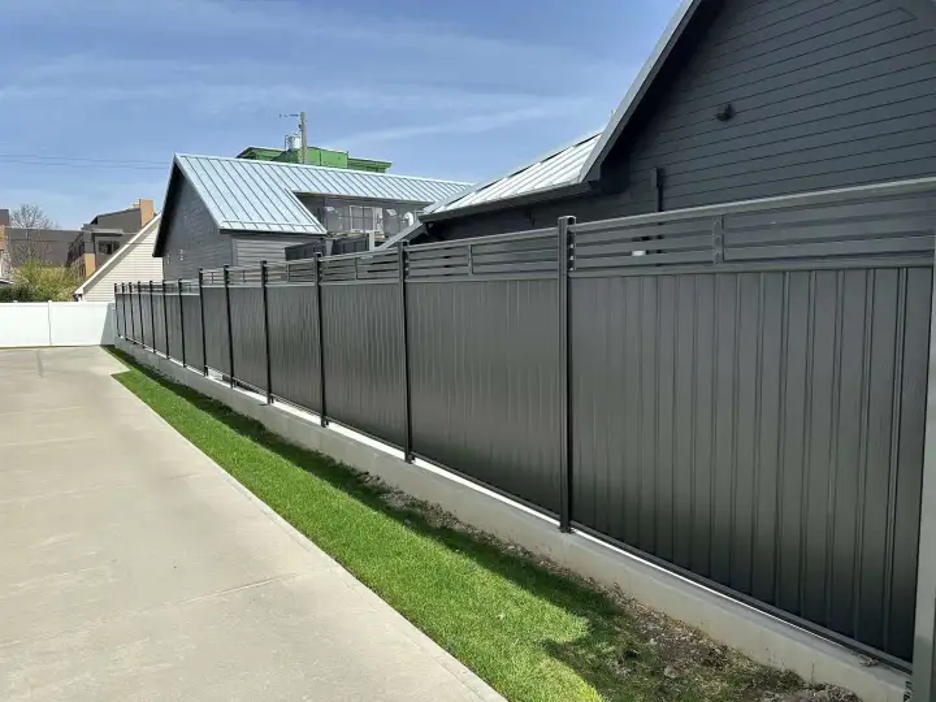New Kids on the Block
In the world of residential and commercial fencing, the choice between aluminum and vinyl has intensified as manufacturing technologies advance. While traditional wood and chain-link fences still dominate many neighbourhoods, these modern alternatives have carved out their own niches, each offering unique advantages that deserve careful consideration.

Material Overview
Aluminum fencing is crafted from aircraft-grade aluminum alloys, making it remarkably strong despite its lightweight nature. These alloys incorporate small amounts of magnesium and silicon, creating a material that resists corrosion while maintaining structural integrity. Modern aluminum fences often feature powder-coating technology that bonds directly to the metal at a molecular level.
Vinyl fencing, technically, polyvinyl chloride (PVC), consists of hollow profiles with internal reinforcement chambers. Contemporary vinyl formulations include UV inhibitors, impact modifiers, and titanium dioxide for enhanced durability. Premium manufacturers often use virgin vinyl rather than recycled materials, ensuring consistent quality and longevity.
Durability Comparison
The durability contest between these materials reveals interesting contrasts. Aluminum's natural oxide layer provides inherent rust resistance, while its structural properties allow it to flex slightly during impact rather than crack. In coastal environments, aluminum's salt resistance gives it a significant advantage over traditional metal fencing.
Vinyl's durability stems from its chemical composition. Unlike aluminum, it won't dent from impact, though it can crack in extreme cold (below -20°F). Real-world testing shows that quality vinyl fencing maintains its structural integrity for 20-30 years, even in harsh weather conditions. However, aluminum typically outlasts vinyl, with documented cases of installations reaching 50+ years.
Cost Analysis
Initial costs tell only part of the story. While vinyl typically costs 10-15% more upfront ($25-35 USD per linear foot installed versus aluminum's $20-30), the total cost of ownership often favours vinyl in certain scenarios.
However, aluminum's salvage value offsets some long-term costs. Current scrap aluminum prices hover around $0.50 USD per pound, making end-of-life recycling a valuable consideration.
Aesthetic Considerations
The aesthetic versatility of these materials differs significantly. Aluminum excels in replicating wrought iron's ornamental elegance, with manufacturers offering sophisticated designs that complement historical architecture. The powder coating process allows for unique finishes, including textured surfaces that mimic more expensive materials.
Vinyl's aesthetic strength lies in its clean, contemporary look. While color options were historically limited, new manufacturing processes have expanded the palette significantly. Companies now offer woodgrain textures that can be remarkably convincing from a distance.

Security Features
Security capabilities diverge significantly between these materials. Aluminum's strength-to-weight ratio allows for taller installations without compromising structural integrity. Current building codes typically permit aluminum fencing up to 8 feet without special permits, while vinyl often requires additional reinforcement above 6 feet.
Innovative security features include embedded sensor systems, which integrate more seamlessly with aluminum due to its conductive properties. However, vinyl's opacity can provide superior privacy, particularly relevant for residential applications.
Maintenance Requirements
Maintenance presents one of the starkest contrasts between these materials. Vinyl's colour permeates the material, making scratch repair nearly impossible but obscuring minor damage. The only required maintenance is occasional cleaning with household soap and water.
Aluminum requires more attention, though still minimal compared to traditional materials. The powder coating can chip, requiring touch-up paint to prevent oxidation. However, aluminum's resistance to biological growth (unlike vinyl, which can develop mold in shaded areas) partially offsets these maintenance demands.

Expert Data
Both aluminum and vinyl fencing have been studied and documented in various environmental conditions, demonstrating their adaptability to different terrains and climates.
Moist Climate Performance - Aluminum Fencing
A case study in a coastal area showed aluminum fencing remained structurally sound after years of exposure to saltwater, high humidity, and strong winds. The fence's corrosion-resistant properties prevented deterioration despite constant oceanic conditions, with no warping or rust formation observed. This aligns with findings that aluminum performs exceptionally well in marine environments due to its natural resistance to saltwater corrosion.
Cold Climate Performance - Aluminum Fencing
Multiple sources confirm aluminum's effectiveness in snowy regions:
- Withstands temperatures down to -40°F without becoming brittle
- Resists damage from freeze-thaw cycles and snowdrifts
- Powder-coated options prevent galvanic corrosion from road salts
Variable Climate Performance - Vinyl Fencing
Real-world installations in Ontario, Canada’s variable climate (-22°F to 86°F) demonstrate vinyl's:
- Resistance to warping across 60°F+ temperature swings
- UV stability maintaining color integrity for 15+ years
- Wind resistance up to 20.5 km/h (12.5 mph) sustained winds
Moist Climate Performance - Vinyl Fencing
In humid regions like Newmarket, Ontario:
- Few reported cases of mold or rot over 10-year observation periods
- Maintains structural integrity despite 80%+ summer humidity
Comparative Performance
While formal academic studies are limited, industry observations and manufacturer testing data confirm both materials perform as advertised across diverse conditions. The choice ultimately depends on specific environmental challenges and aesthetic preferences.
Conclusion
The choice between aluminum and vinyl fencing ultimately depends on specific site conditions, climate, and intended use. Aluminum's superior strength, design flexibility, mold-proof nature and longevity make it ideal for security applications and architecturally significant installations. Vinyl's low maintenance requirements and competitive pricing make it an excellent choice for residential privacy fencing, particularly in moderate climates.
Neither option represents a universal solution, but understanding these materials' distinct characteristics enables informed decisions based on individual circumstances. As manufacturing technologies continue to evolve, the gap between these materials may narrow, but their fundamental differences will likely continue to define their optimal applications.



